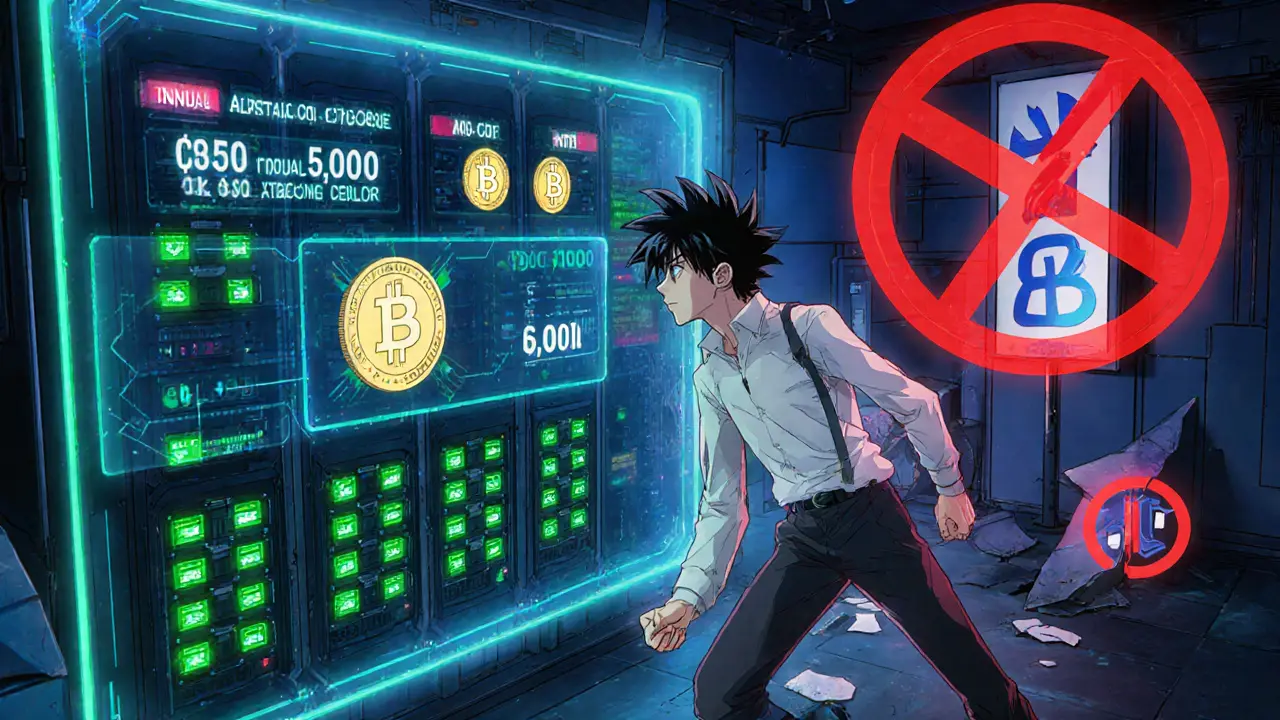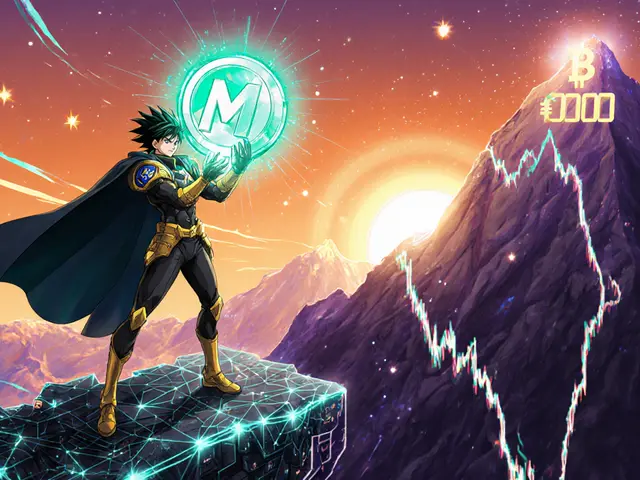Iranian Stablecoin Limit Calculator
Stablecoin Purchase and Holding Limits
Based on Iranian regulations effective September 27, 2025:
- Annual Purchase Cap $5,000
- Total Holding Ceiling $10,000
Your Compliance Status
Quick Take
- Since Dec2024 the Central Bank of Iran (CBI) has blocked all rial‑to‑crypto payments on domestic platforms.
- From Feb2025 onward any crypto advertising inside Iran is illegal.
- Effective 27Sep2025 individuals can buy only$5,000 worth of stablecoins per year and hold a maximum of$10,000.
- Crypto mining remains legal and generates roughly$1billion annually, but the government caps electricity use.
- A new digital rial and a speculative‑asset tax are being phased in to tighten control.
When it comes to digital money in Iran, the rules feel like a roller‑coaster. The government wants to squeeze every bit of value out of mining, yet it clamps down hard on anyone trying to use crypto as a shortcut around the rial’s collapse. Below is a plain‑English rundown of every major restriction that landed in 2024‑2025, why it matters, and what a trader or hobbyist needs to do to stay on the right side of the law.
Iranian rial crypto trading restrictions are the set of rules the Iranian government has imposed on buying, selling, holding, and advertising cryptocurrencies that involve the national currency, the rial.Why Iran’s Crypto Rules Look So Different
The Islamic Republic faces two opposing pressures. On one hand, sanctions have choked off traditional banking links, so officials see crypto mining as a way to earn hard‑currency revenue. On the other, the rial has been sliding at double‑digit monthly rates, and the state wants to stop citizens from fleeing to foreign‑denominated assets. The result is a hybrid regime: mining is encouraged, but any domestic crypto‑to‑rial transaction is almost forbidden.
Central Bank of Iran (CBI) the monetary authority that drafts and enforces the crypto restrictions described here.Regulatory Timeline - The Key Milestones
| Date | Restriction | Primary Impact |
|---|---|---|
| 27Dec2024 | Block all rial‑to‑crypto payments on Iranian websites | Exchange platforms forced to apply for CBI licences; most domestic fiat‑crypto pairs shut down. |
| Jan2025 | Selective unblocking via CBI‑controlled API | Only approved exchanges can operate, and they must send full transaction logs to the bank. |
| Feb2025 | Ban on any crypto advertising, online or offline | Media, influencers, and banner networks cannot promote digital assets. |
| 27Sep2025 | Stablecoin purchase caps ($5,000/yr) and holding ceiling ($10,000 total) | Individuals and firms must reduce excess holdings within one month. |
| Aug2025 | Law on Taxation of Speculation and Profiteering | Capital‑gains tax applied to crypto trades, similar to gold or real‑estate. |
Stablecoin Limits - What the Numbers Mean
Stablecoins have become the de‑facto cash substitute for Iranians because they hold value against the US dollar. The CBI’s September order pins down two hard limits:
- Annual purchase cap: $5,000 per person or legal entity. If you bought $6,000 in USDT in 2025, you’ll be fined and forced to sell the excess.
- Holding ceiling: $10,000 total at any moment. Exceeding that triggers a mandatory sell‑off within 30days, or the bank can freeze the assets.
For a family that saves $300 a month, the cap translates to roughly 33months of savings before hitting the ceiling - a stark reminder that the rial’s inflation is pushing people to look for alternatives faster than the law allows.
Advertising Ban - No More Crypto Promos
In February 2025 Iran introduced one of the world’s strictest crypto‑marketing prohibitions. The ban covers:
- Printed flyers, billboards, and TV spots.
- Social‑media posts, YouTube videos, and livestreams that mention buying or selling crypto.
- Any third‑party service that markets a crypto product to an Iranian audience, even if the service is based abroad.
Violations can lead to heavy fines, imprisonment, or the shutdown of the offending platform’s Iranian IP address. As a result, most Iranian crypto influencers have gone silent, and exchange websites now display a generic “service unavailable in your region” notice.

Taxation of Crypto Speculation
August 2025 saw the passage of the “Law on Taxation of Speculation and Profiteering.” Key takeaways for traders:
- Short‑term crypto gains (held <12months) are taxed at 25% of profit.
- Long‑term gains (held >12months) enjoy a reduced 15% rate.
- Reporting is mandatory through the CBI’s API‑linked exchange system; failure to declare may trigger audits and asset freezes.
The tax is collected in rial, meaning you’ll need to convert any crypto profit back into the national currency before paying the bill - another hurdle for those trying to keep money out of the formal system.
Digital Rial - The State’s Own Crypto
To create a government‑controlled alternative, Iran launched a central‑bank digital currency called “Rial Currency.” It is not mined; the CBI creates and destroys units based on monetary policy, and each digital rial is pegged 1:1 to paper cash.
Currently, the pilot runs on Kish Island, allowing residents to pay for utilities and transport via a mobile wallet. The project is meant to reduce reliance on foreign dollars, but it is still separate from the broader crypto restrictions - you can’t use the digital rial on any public exchange.
Mining - The One Area the State Encourages
While the rial‑to‑crypto flow is throttled, Bitcoin mining is a thriving state‑backed industry. Iran’s cheap electricity (about $0.02/kWh) attracted dozens of large farms, producing roughly $1billion a year - close to 4.5% of global mining output.
However, the grid has become strained, so the government now caps consumption for mining operations. Operators must submit usage reports, and those who exceed limits face forced power cuts. The paradox is clear: the regime wants the foreign cash mining brings, yet fears a blackout that would cripple homes and industry.
Real‑World Impact on Users
Regulation doesn’t exist in a vacuum; Iranians adapt fast. Here are the most visible moves:
- Tether freeze (2July2025): Tether froze assets linked to 42 Iranian wallets, many tied to the domestic exchange Nobitex. Users were forced to move funds out of USDT.
- Shift to DAI on Polygon: Influencers urged traders to convert USDT into DAI via the Polygon network, which offers lower fees and faster confirmation. This migration let users keep a stablecoin foothold despite the USDT crackdown.
- Underground markets: Even with the caps, a shadow market trades in crypto‑to‑rial pairs on peer‑to‑peer apps. Prices are typically 10‑15% higher than official rates, reflecting the risk premium.
These actions show a cat‑and‑mouse game: the state tightens the leash, and users find loopholes that keep capital flowing.
Compliance Checklist for Iranian Crypto Participants
If you are a trader, miner, or developer, follow this short list to avoid penalties:
- Licensing: Only use exchanges that have a CBI licence and that feed data through the official API.
- KYC/AML: Prepare full ID, address, and source‑of‑funds documents. The bank audits these records quarterly.
- Stablecoin caps: Track yearly USDT/DAI purchases; stop buying once you hit $5,000.
- Holding ceiling: Regularly check your wallet balances; sell or convert excess before the 30‑day deadline.
- Tax reporting: Keep a spreadsheet of every trade, calculate profit, and submit the figures through the CBI portal before the annual deadline (typically 31March).
- Avoid advertising: Do not post crypto‑related promotions on any public platform, even if the audience is outside Iran.
- Mining compliance: Register your mining operation, monitor electricity usage, and stay under the allocated wattage limit.
Missing any of these steps can lead to frozen accounts, hefty fines, or even criminal charges. The safest route is to stay within the official channels, even though that means accepting lower liquidity and higher transaction costs.
What’s Likely to Change Next?
Analysts expect two possible directions:
- Further tightening: If sanctions deepen, the CBI may lower the stablecoin cap to $2,000 and introduce a stricter audit of offshore wallets.
- Partial liberalization: To keep miners happy, the state could create a dedicated “mining‑only” fiat gateway that lets miners convert Bitcoin earnings to digital rial without going through the standard exchange route.
Either way, staying informed and keeping a compliant record will be the biggest advantage for anyone dealing with crypto in Iran.

Frequently Asked Questions
Can I buy Bitcoin with Iranian rial inside Iran?
No. Since December2024 the Central Bank blocks any direct rial‑to‑crypto transaction on domestic platforms. You must use an exchange that has a CBI licence and that routes the trade through the bank’s API, which essentially converts rial to a foreign currency first.
What happens if I hold more than $10,000 in stablecoins?
The CBI gives you a 30‑day window to reduce the balance. Failure to comply can result in account freezing, mandatory liquidation, and a fine equal to 20% of the excess amount.
Is the digital rial the same as other cryptocurrencies?
No. The digital rial is a central‑bank digital currency (CBDC) issued by the CBI. It is fully backed by paper rial, cannot be mined, and is only usable in the pilot area on Kish Island.
Do the stablecoin caps apply to DAI and USDT equally?
Yes. The 5% annual purchase limit and the $10,000 holding ceiling cover all USD‑pegged stablecoins, regardless of the issuing blockchain.
How is crypto mining taxed in Iran?
Mining revenue is treated as commercial income. Operators must declare earnings in rial and pay the standard corporate tax rate of 25% on net profit.









Comments (13)
emmanuel omari
June 12, 2025 AT 23:35 PMThe Iranian regime has finally shown some backbone by slamming down the fiat‑to‑crypto bridges. It’s a clever move to keep capital flight in check while still harvesting the mining boom. The $5,000 purchase cap and $10,000 holding ceiling are blunt instruments, but they send a clear signal that the state won’t tolerate uncontrolled speculation. By forcing every exchange to feed transaction logs to the Central Bank, Tehran can monitor the flow and punish the black market. This kind of top‑down control is exactly what developing nations need to protect their sovereign currency. If other countries follow suit, we might see a new era of regulated crypto that actually serves national interests instead of pure profit‑seeking sharks.
Richard Herman
June 17, 2025 AT 14:41 PMWhile the restrictions are certainly firm, it’s worth remembering that they also push people toward innovation in compliance tools. The API‑linked reporting could become a model for transparent crypto ecosystems, allowing regulators to keep an eye on illicit flows without stifling legitimate use. At the same time, miners benefit from cheap electricity, which can fund public projects if the revenue is channeled wisely. A balanced approach-tight on capital flight, loose on productive mining-might actually boost economic resilience.
Prince Chaudhary
June 22, 2025 AT 05:48 AMFor anyone navigating these rules, the first step is to log every purchase and holding amount in a simple spreadsheet. Set a reminder for the 30‑day sell‑off window, and treat the $5,000 cap as a hard budget line. Staying within licensed exchanges will keep you out of trouble, and the KYC requirements are manageable if you keep your ID documents handy. Remember, compliance isn’t just a penalty‑avoidance tactic; it’s a way to preserve your crypto assets long‑term.
John Kinh
June 26, 2025 AT 20:55 PMWow, another regulation to make life harder… 🙄
Mark Camden
July 1, 2025 AT 12:01 PMIt is morally indefensible for any government to impose such draconian financial controls on its citizens. By limiting personal liberty to purchase stablecoins, the state violates basic principles of economic freedom. Moreover, the punitive fines and potential imprisonment for exceeding caps constitute an overreach of authority that cannot be justified under any respectable legal framework. Citizens deserve the right to manage their assets without fear of arbitrary seizure.
Evie View
July 6, 2025 AT 03:08 AMThese rules are a crushing weight on anyone trying to protect their savings from hyperinflation. The anxiety of constantly watching the $10,000 ceiling is unbearable, and the looming 30‑day deadline feels like a threat hanging over every wallet. It’s not just numbers; it’s a daily emotional battle that leaves many feeling powerless and desperate.
Sidharth Praveen
July 10, 2025 AT 18:15 PMStay focused, keep tracking your limits, and you’ll navigate the system without breaking any rules.
Sophie Sturdevant
July 15, 2025 AT 09:21 AMUtilizing on‑chain analytics and decentralized aggregators can help you monitor real‑time exposure. By leveraging layer‑2 solutions, transaction fees stay low, allowing you to adjust holdings efficiently while staying compliant with the $5K/yr threshold.
Nathan Blades
July 20, 2025 AT 00:28 AMIran’s latest crypto policy is a fascinating case study in state‑driven financial engineering. First, the outright ban on rial‑to‑crypto payments forces users onto licensed exchanges, which creates a data pipeline directly to the Central Bank. This pipeline, while intrusive, gives regulators unprecedented visibility into transaction flows, potentially reducing money‑laundering activities. Second, the $5,000 annual purchase cap is modest, but it reflects a strategic decision to limit exposure to foreign‑denominated assets, effectively trying to preserve the domestic currency’s relevance. Third, the $10,000 holding ceiling serves a dual purpose: it caps the total amount of stablecoins an individual can control, and it creates a clear threshold for enforcement actions, such as forced liquidation within 30 days. Fourth, the mining sector remains the standout exception; by keeping electricity cheap, the government capitalizes on Bitcoin’s hash‑rate revenue, which can be funneled into the national treasury. However, the recent cap on electricity usage for miners signals a balancing act between revenue generation and grid stability. Fifth, the advertising ban eliminates a major vector for crypto adoption, silencing influencers and curbing organic market growth. This suppression may inadvertently push community education underground, fostering a clandestine knowledge base that could be harder to regulate. Sixth, the new taxation law on speculative gains aligns crypto with traditional asset classes, imposing a 15% rate on short‑term profits. While this introduces a compliance burden, it also normalizes crypto within the broader fiscal framework. Seventh, the introduction of a central‑bank digital rial offers a state‑controlled alternative, but its limited pilot scope indicates cautious rollout. Finally, the overall architecture showcases a paradox: the state encourages mining for hard‑currency inflows while simultaneously choking off the channels that would allow citizens to convert that wealth into stable, foreign‑denominated assets. Understanding these nuances is crucial for anyone looking to operate within Iran’s crypto ecosystem, as each rule interacts with the others to create a tightly regulated yet economically significant landscape.
Somesh Nikam
July 24, 2025 AT 15:35 PMGreat overview! 😊 Remember to keep a dedicated ledger for each calendar year so you can easily verify you haven’t crossed the $5K purchase limit. A simple Google Sheet with columns for date, amount, and asset type works well. Also, set up calendar alerts a week before the 30‑day sell‑off deadline to avoid accidental breaches.
Jan B.
July 29, 2025 AT 06:41 AMUse a licensed exchange and stick to the caps. Track everything.
MARLIN RIVERA
August 2, 2025 AT 21:48 PMThe whole system is a bureaucratic nightmare that will only drive users to the black market, undermining any claimed stability.
Debby Haime
August 7, 2025 AT 12:55 PMKeep your eyes on the compliance deadlines and stay positive-you’ve got this! By staying organized and following the rules, you can still benefit from the mining boom while protecting your assets.